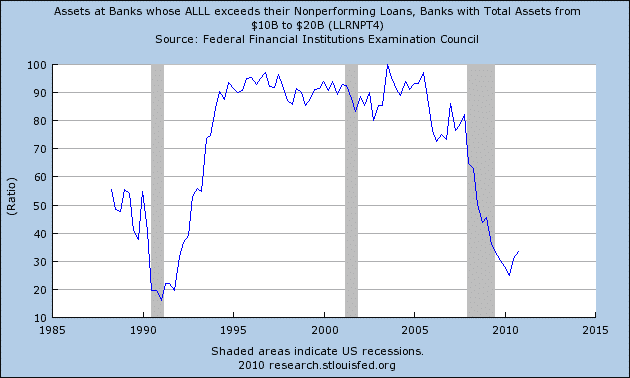MBS Putbacks Uncertain but Other U.S. Bank Problems Also Loom
Jonathan R. Laing reports in Barrons that the exposure of U.S. banks to liability for putbacks of defective MBS (mortgage backed securities) is greater than the $52 billion reported last week from the findings of the COP (Congressional Oversight Panel). The Laing article has a total potential liability of $86 billion for U.S. banks.
What is curious about these two reports, even more than the fact that the data reported in Barrons (see graphic below) is 65% greater than the total from the COP report, is that the two data sets do not even cover the same banks.
There is overlap in the two sets of banks included in the separate reports, but one bank (WFC – Wells Fargo) is not in the Barrons report and Goldman Sachs (GS) and Morgan Stanley (MS) are not mentioned in the COP report. The table below summarizes:
The Barrons article data for the three banks that overlap the COP set of banks is $66.9 billion. That is ~$15 billion greater than the COP report and the Barrons data doesn’t even include one of the four COP report banks (WFC).
To confuse things further, Barry Ritholtz at The Big Picture reports that Chris Whalen has an even bigger exposure estimate.
Sorting out this putback situation is getting more and more complicated as time goes by. At this point I throw up my hands and call for arbitration.
To add another level of angina to the situation, Reuters is reporting that Barclays Plc (BCS) estimates that U.S. banks will have to increase capital by $100 billion to $150 billion to meet Basel III rules requirements. Reportedly 90% of this capital will be required by the top six U.S. banks. When you add this amount of exposure to other potential losses with insufficient provisions, plus the MBS putback overhang, the earnings outlooks for banks in the coming years is quite bleak.
Beyond the question of earnings one still has to question solvency. The following graph shows that loss provisions for banks are quite insufficient.
The situation for the largest banks is better, but still far below historic normal levels.
To aid those not familiar with the terminology, here is a quote from the St. Louis Fed Fred data base:
Each bank is classified by whether the ratio of its allowance for loan and lease losses to nonperforming loans is greater than one. The allowance for loan and lease losses is the sum of call report items rcfd3123 and rcfd3128. Total nonperforming loans equals the sum of call report items rcfd1403 and rcfd1407. For each size category, the sum of all assets held by banks where this ratio is greater than one is divided by the sum all assets held by banks in the class.
Thus the above graphs indicate that less that 20% of the assets in all banks have sufficient loss provisions and about 33% of large bank assets are covered by sufficient loss provisions. These loss provisions apply only to currently nonperforming loans (and leases) and therein lies another problem. The current extend and pretend policies of the Fed, the Treasury and the banks themselves are delaying identification of nonperforming assets as long as possible. They are waiting for the recovery fairy to make things all better again.
Well, indications are that the fairy is not waving the wand yet and things could get worse if housing prices continue further into their current dip.
Related Articles
The Great Debate©: Residential Construction is Dead – Or Is It? by William C. Wheaton and Gleb Nechayev
Fewer Foreclosures but Housing Outlook Worsens by John Lounsbury
Housing price Decline Continues by Steven Hansen




And this why the Fed is desperately trying to drive asset prices higher “than they would be otherwise.” To paraphrase Keynes, this is like trying to loose weight by buying a bigger belt.